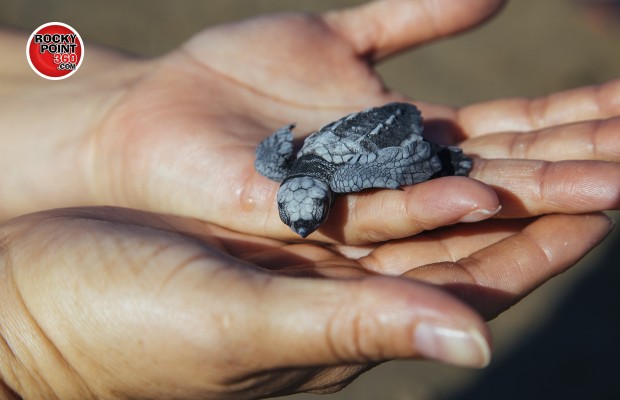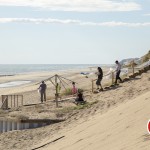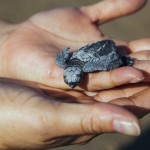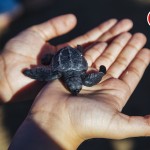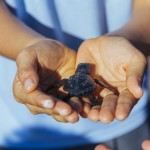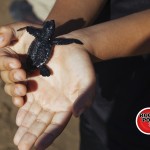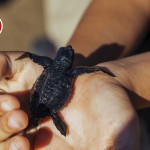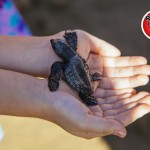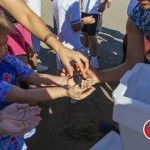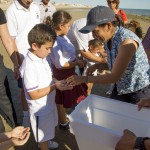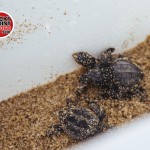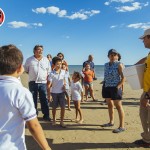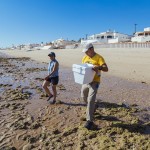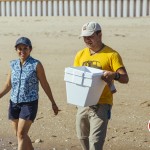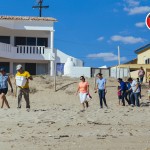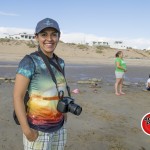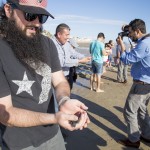I was told recently hatched turtles were going to be released, and just like that I got up from the computer and looked over at my daughter, thinking how she would like to witness such an event…. “Let’s go Sofia, put on your shoes and let’s go see the baby turtles, vamos, let’s go!” and in 15 seconds she was ready. Before leaving, I once again called the person who had told me, just to make sure the release was happening – taking into account a few of the turtles had been released just the day before… indeed, they confirmed, it was happening, NOW, that day they would also be releasing turtles into the sea (Oct. 21).
As we rushed out of the house, we ran into our neighbor who was leaving with her mom, and invited her along – plus my own Plan B was that she’d help with Sofia, who has the distinction of not being very still. We packed into the car, got some gas, and drove toward Las Conchas. At the entrance to CEDO, however, we didn’t see any indication of the event. “It’s in Section 4,” CEDO Deputy Director Hiram Peña said, “there you’ll see some stairs and then go to the end…”
We headed toward Section 4, getting lost somewhere along the way, and once back on the main road kept a look out for stairs, and then finally walked to the end. There we found staff from CEDO, a number of kids, and invited guests were already standing guard over styrofoam coolers that held the 68 turtles – which had recently cracked through their shells and would soon be released into their habitat. As the coolers were opened, I asked if I could take a few pictures. There they were, restless little turtles piled on top of each other – even more restless than the day before, according to those in charge of the turtle release.
Between the emotion of seeing the turtles and then wanting to touch them, all of us helpers piled up somewhat on our own and then voices called for us to form a line so the turtles could be released in order to make their trek to the sea.
Paloma Valdivia of CEDO put oxygenated water into the hands of those who would hold the turtles before helping them to their destination. While I was asking about the oxygenated water, a small turtle was placed in Sofia’s hand – which she let go of when tickled by the fins, but I managed to catch to make sure it didn’t fall. A few minutes later, I almost crushed another as I tried to find the best photo angle – not providing the best example for my restless daughter.
And then, after being placed in the sand, little by little the fragile sea reptiles made their way to the calm sea. The children accompanied them on their journey, while some US tourists (or maybe residents) happened to come across the release – also just barely dodging stepping on a turtle. Meanwhile, photographers sought to capture the best image, each one better than the other.
Although instructions to avoid any injury to the turtles were constant, “Don’t walk backwards!” “Careful when walking!” “Don’t push them!”, the tiny creatures put themselves in risk’s way every 3 minutes or so, possibly due to the lack of experience of the assistants, as we are not used to spectacles of this magnitude.
The turtles each took their own time; the first one speedily and without stopping, which headed straight into the water, followed by a trio that seemed to be marching, and so on and so on. Bit by bit they submerged into the sea, while sweet voices could be heard cheering them on, thrilled with what was happening!
Suddenly, as if an obligatory character from a movie, a seagull appeared and tried to get close to the little ones. Biologist Carolina Cardenas cried out, “A seagull! There it goes!” Carlo Lan lurched into action, transforming from assistant to afternoon hero. He gathered everyone and ran, trying to scare off the seagull. When the bird had already made three attempts to capture the small prey, though faced with the pressure of shouts warding it off, it finally flew away.
After finding biologist Cardenas, I asked her a series of questions and then followed her around as we talked, “Where did the turtle lay her eggs?” “In that dune, here in Las Conchas.” “Where were they stored?” “The guards, Don José [from Las Conchas] called us; we notified PROFEPA (Environmental Protection) and then I took them to Mayan Palace. We stored the eggs there in these boxes in a room set at the ideal temperature of 28° to 30°C (82° to 86° F) so they could hatch, and here they are. There were 101 eggs and today we’ve brought 68 turtles; yesterday (Oct. 20th) we brought 13 but only 3 made it into the sea, we returned the rest to the cooler.”
When fewer than half the turtles were still on their way over the sand, we decided to head back, though not before calling to my daughter and neighbor who wanted to stay just a little longer to enjoy the sea water and the cloud peppered sky that made this afternoon particularly unique and special, here in our port where the temperatures usually make it a challenge for the hatching of turtle eggs to become a reality.
